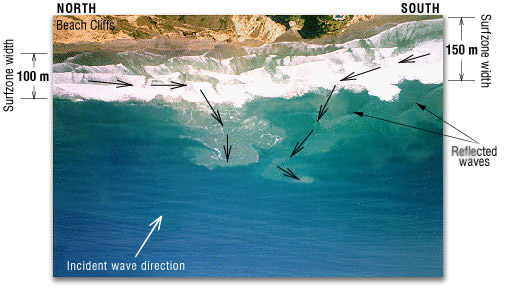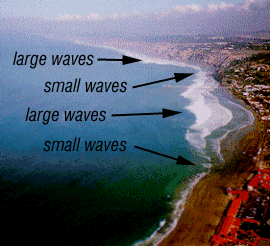A long-term objective of nearshore oceanography is to understand the processes shown in the photograph below, including the evolution of surface gravity waves propagating across the continental shelf through the shoaling region and surf zone, and the corresponding inner shelf and breaking-wave driven nearshore circulation, sediment transport, and subsequent bathymetric change.
FIGURE 1: Aerial photograph near Black’s Beach in Southern California showing the effect of offshore canyons on surfzone processes. Alongshore variations in wave height, caused by propagation over the canyons, result in variation of the surfzone width from about 150 m at the southern edge of the image to 100 m at the northern edge. The waves propagating at large oblique angles relative to the shoreline (thin arrows point to wave crests) are nearly perpendicular to the incident wave direction and may have reflected from the steep canyon walls (located offshore and south of the image). The complex, breaking-wave-driven circulation includes converging alongshore flows and sediment-laden, offshore-directed rip currents that extend well outside the surf zone (thick arrows).
To attain this objective, scientists are developing a nearshore processes community model. The assumptions and physics underlying the model hypotheses are tested with field observations, including those obtained in a suite of experiments conducted on a barred beach on the gently sloping, wide continental shelf near Duck, North Carolina. In contrast to the North Carolina coast, many continental shelves have abrupt irregular bathymetry that causes large gradients in the wave field outside the surfzone. The steep topography of Scripps and La Jolla Submarine Canyons in Southern California produces dramatic changes in wave energy over alongshore distances of only a few hundred m (FIGURE 2), resulting in complex nearshore circulation and morphological change.

FIGURE 2b: SWAN model prediction of wave heights along the southern California coast for 17 s swell arriving from 295 degrees. The strong alongshore gradients in wave height predicted by the model are similar to those observed. Black curves are depth contours. The model predictions were performed by J. Kaihatu (NRL).
During NCEX scientists will focus on determining how abrupt coastal bathymetry affects nearshore processes, including:
- wave propagation
- circulation
- swash
- morphological evolution

